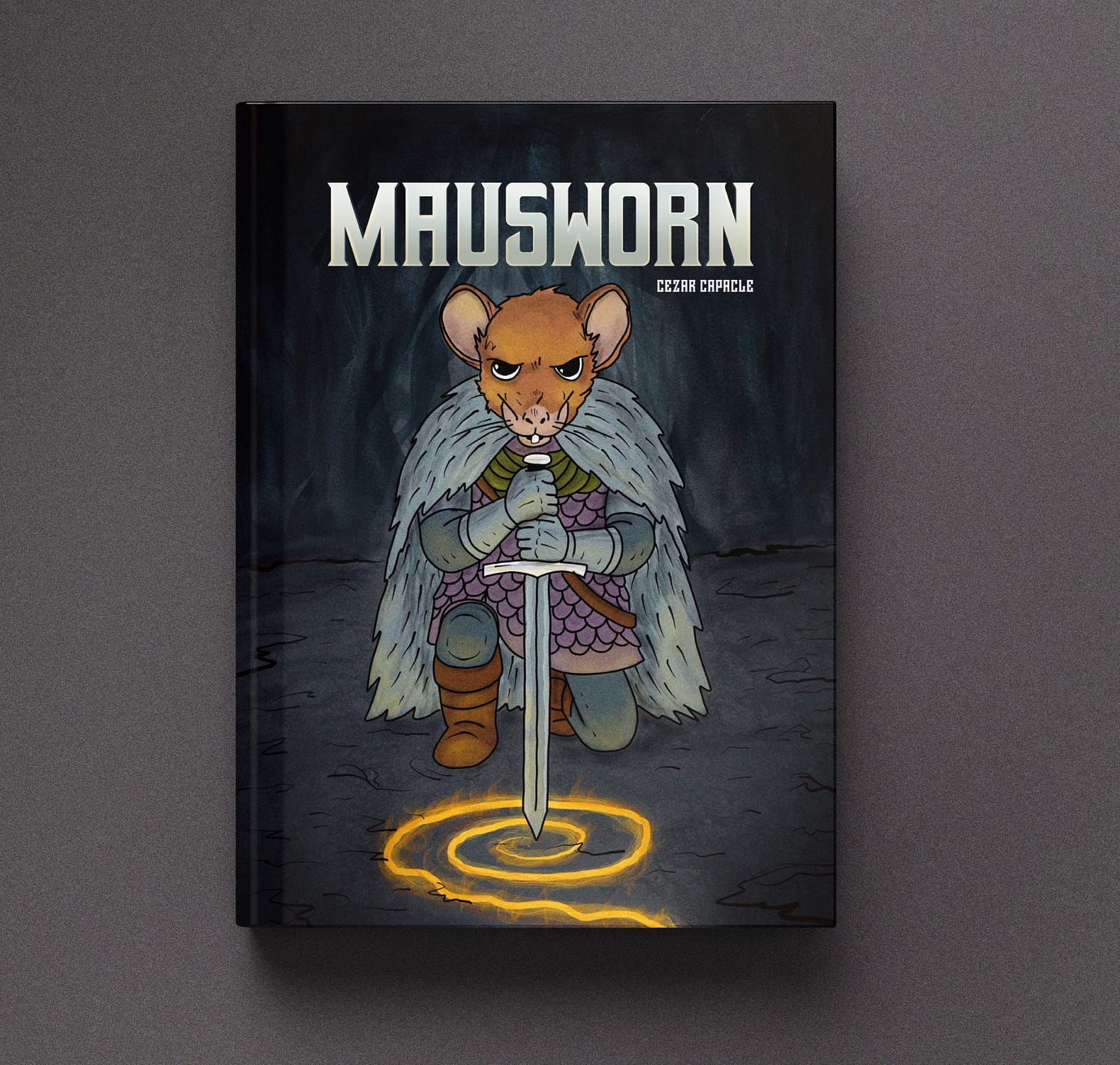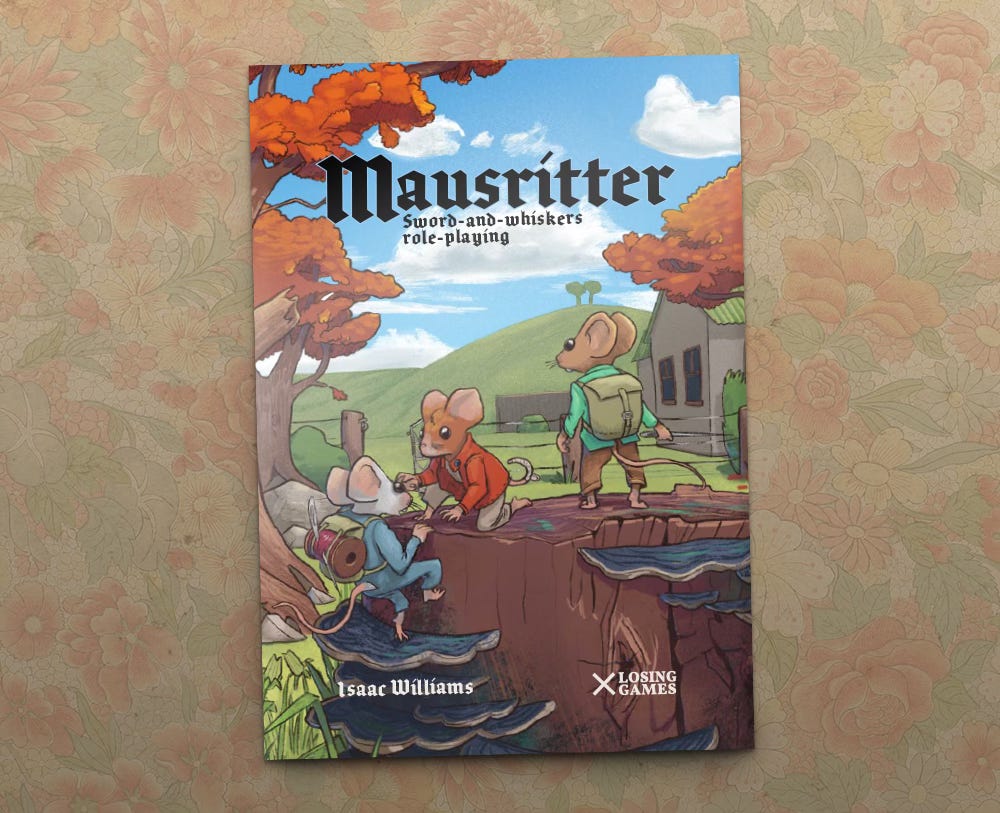Last week, on Free RPG Day, Isaac Williams announced the publication of the official Mausritter’s SRD. I’d assume everyone that reads this newsletter is somewhat familiar with Mausritter, but in case you are not, this is a beloved “sword-and-whiskers” RPG that lets you take on brave mice characters into a dangerous world. Since its release, it has taken the community by storm (their library currently has over 1,000 resources, spanning from adventures to expansions and hacks).
I love Mausritter for multiple reasons. The whole concept of mice adventurers, the inventory system, the minimalist rules, the tools it provides. I even ran it for my nephew and nieces a while ago, and we had a blast. And yet… well, I can’t turn off my game design brain, so even while running it, I was thinking of ways I could make it more my own—not better, mind you, just more catered to my preferred style of play.
So I was really excited when the SRD was out, and my initial thought was to create a new custom system for it, keeping the bits I liked. But then… a second thought occurred.
I just happen to know another game that has a comprehensive SRD out.
A game that, honestly, was the most influential in my early game designer career.
That game is, of course, Ironsworn.
Again, I’d assume you’re familiar with it, but to put it briefly, this is a somewhat dark fantasy game of perilous quests that truly showed me how much the mechanics and procedures of a game can support non-journaling solo play efficiently. In my mind, a masterpiece.
I am aware of an unofficial Mouse Guard playkit for Ironsworn that is quite nice, really. But that is not what I am going for.
The vision
I want to combine my favorite bits of both games, add my own spin to it (I can’t help myself) and release a standalone game that allows you to play mouse adventures solo or in a group. And I am going to this in the open (more on that below).
And with that, the Mausworn project was born.

Here’s my initial view:
Ironsworn's core dice roll and a streamlined set of moves. Mausworn will use the main d6 vs. 2d10 engine, but just a handful of moves (one catch-all for action, one for magic, one for complications, one catch-all for progress, and a couple of new ones I came up with).
Mausritter's inventory system—both card and cardless. I love the inventory management in Mausritter and the idea of Conditions taking inventory space.
Ironsworn's tracks, but Mausritter attributes. So we have STR, DEX and WILL (which is my hope can facilitate using Mausritter's published modules with this system) but no HP or attribute damage. Instead, Health, Spirit, Momentum and Pips (instead of Supply, since we have the inventory).
Tightly structured procedure. Mixing Mausritter's adventuring sites and hex ideas (Shifts, Weather, encounters) with Ironsworn's narrative flow and scene challenges, aided by my own experience with my games, we end up with a core loop that is easy to follow and flexible enough to create emergent stories, whether you are playing solo or in a group.
I want to use this space to discuss the logic behind these choices, but before Substack starts telling me that this post is too long, let me share you where the initial drive came from, and then I’ll leave my other ideas to tweak the rules for a next post.
A matter of style
So what prevented from fully enjoying Mausritter as-is derives from the fact that it is a game rooted on OSR principles. Now, before you type an angry comment, don’t get me wrong: there’s a lot to love in this creative space, and if that’s your jam, all the power to you. It just so happens that there are a couple of design choices that don’t suit my personal (and current—they might change) design philosophies, namely:
Random stats. I love random character concept. I do not love random character competence. I am probably missing something blatantly obvious, but even after a handful of blog posts and analyses, I can’t wrap my head around how it can be fun to have a party where one player succeeds 80% of the time and the other, 30% (“by not rolling often“ might be an answer, which lands into another preference friction). My niece rolled a mouse with 1 HP, so most of their choices during the game were “I’ll stand back and wait”. A poor roll on character creation robbed her from the thrill of taking risks. Some might find this a fascinating opportunity for creative engagement—and good for you! I, personally, don’t see the appeal.
High lethality. See above. I know, if there’s a place where characters that die easily fits the theme, it’d be on a game about tiny mice in a dangerous world. But I believe that the sense of danger and stakes can be represented in a multitude of ways that allow for you to have meaningful consequences and story development, without the need to treat your character as a disposable piece of paper with zero attachment. It honestly baffles me when I hear “without the constant presence of the risk of death, the game has no stakes”. Like, really? Did you ever think for a second that Frodo wouldn’t make it? Did it rob you from the tension and sense of peril of the journey? Sorry, venting a bit. Point is: mouse death is still on the table, but I want it to be meaningful, and moreover, I want engaging stakes and consequences that go beyond “you die, roll another character”.
Again, don’t see this is a jab at a particular playstyle. It is very much a result of reflections through the perspective of a storygame-brain-wired individual (me). Let me break the tension by showing you my first study for the character sheet.
I have a lot more to talk about, like how keeping Mausritter’s three Stats instead of Ironsworn’s five presented its own challenges—particularly the absence of an Intelligence equivalent—and an unexpected solution through a custom move (I’ll just say that encapsulating an OSR principle via a PbtA-like move was extremely amusing). But this newsletter is too long already.
If you want to follow along the development of the game, I am doing it in the open. That is, I’ve published an itch page and you can claim the game now FOR FREE, which will give you access to the development document. It is currently empty (my scribbly notes are not for the public eyes yet), but it will be constantly updated as I develop the game. You can even leave comments and suggestions on the doc itself!
And, as a token of appreciation, if you claim the game today, I’ll offer you a discount on the final PDF whenever it is released. Sound good?
Since publishing it less than 48 hours ago, more than 400 people joined, so that was baffling, exciting and scary. I do hope I can deliver!
Anyway, get access to it on the button below, and subscribe to the newsletter for future dives into the development of this (and other) games!






Im so down for this. Seriously excited to see where it goes.
Just played Mausritter with my kids for the first time and completely agree on the challenge of being punished by randomness. Especially for new TTRPGers, there is always a caution to do anything that might lead to the “loss” of a character. Looking forward to seeing this develop!